Birds are among the most beautiful, intelligent, and fascinating animals on Earth. The world is full of beautiful birds and yet some are dangerous as well. These winged creatures come in a staggering variety of shapes, sizes, and colors.
There are birds that can swim, dive and fly underwater. There are birds that can walk and hop on one leg at the same time. Birds can also play instruments, dance, and speak human language. In short, there are lots of cool things about being a bird. Also, they can fly literally the coolest thing about birds is they are the true king of the sky.
How dangerous are birds?
Even though birds look like little angels and mostly behave like them too, there are many dangerous birds in the world. Most birds are harmless and won’t attack you unless threatened. Some of them are man-eating giants, while others are small and cute.
Birds also pose some of the most dangerous threats to human life as well. Learn more about these winged wonders so you can protect yourself from them! Birds are some of the most common inhabitants in almost every habitat in the world.
However, this abundance sometimes comes at a cost. Many birds are territorial and will attack those who invade their space or get close to their nests or eggs. Others like to keep an eye on intruders and will mount an attack if they sense danger. Some even hunt down other animals for food or induce fear in predators through a display or hunting tactics.
The list of the 10 most dangerous birds in the world includes some of the largest and most powerful birds, such as eagles and owls. These birds can cause serious injury or even death with their sharp talons and beaks.
Here are the 10 Most Dangerous Birds in the World.
10. Macaws
First up, we have the Macaws, a brightly colored parrot that is native to South America. There are 19 species of macaw, which are highly prized as pets due to their attractive colors and large size. There are many recorded incidences of macaws attacking humans, often when they are being transported. They have very sharp beaks and are able to inflict serious damage.
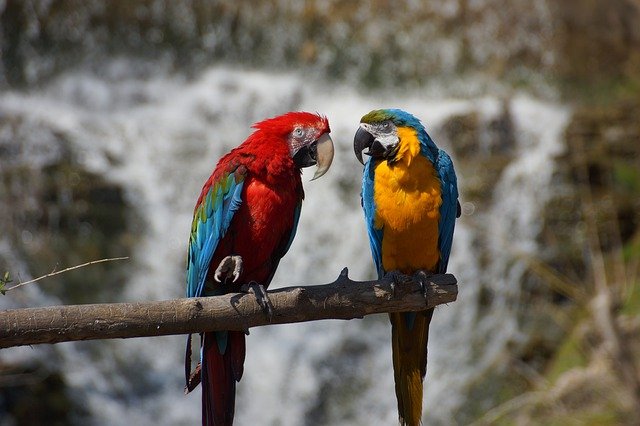
Macaws have one of the most powerful and painful bites of all parrots. Compared to Cockatoo bites, Macaw bites are twice strong as they have a bite force of 500 to 700 psi. The bite of the green-winged macaw is estimated to be 2,000 psi. However, a single bite cannot rip off a finger. There are times when they really draw blood and you have to get stitches.
Macaws are very intelligent birds that can be trained to do many different things. They are found in many parts of the world and are frequently traded as pets. Macaws can live for around 60 years in captivity. They feed on fruits and nuts and use their beaks to crack open seeds. If a macaw is kept as a pet, it is best to keep it away from children and other pets.
9. Snowy Owl
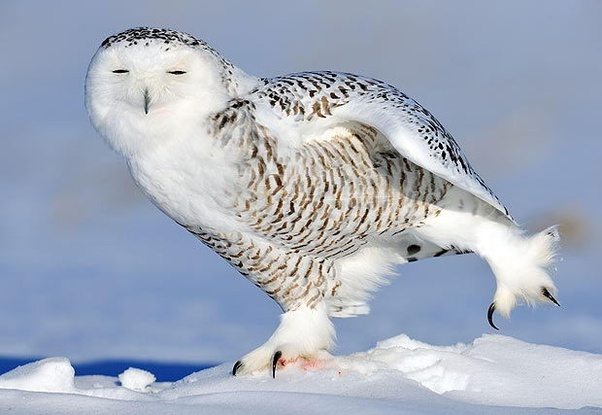
Next up on our list is the beautiful Arctic or Snowy owl – a large owl that inhabits the Arctic regions of Northern America, Arctic tundra, Alaska, and Northern Canada. This species is featured in many fairy tales and myths. It is also known as the Northern owl, great white owl, giant Arctic owl, and ghost owl.
They are only active during certain times of the year. In autumn, it will migrate to temperate and subarctic regions, where it will spend the winter. It is a carnivorous animal that feeds on fish, rodents, hares, etc. It has been known to target people when hunting for food, as it can kill animals almost as large as itself.
8. Kori Bustard
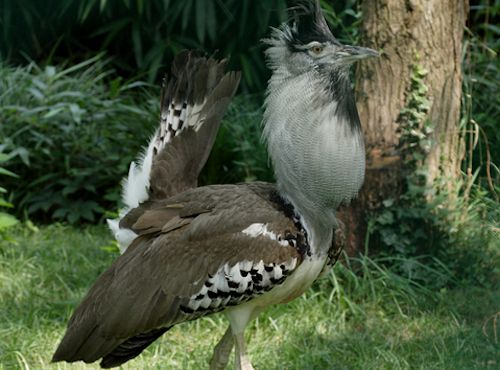
Next up on our list is the kori bustard. This large bird is found in parts of Africa and Asia. The Kori Bustard is Africa’s heaviest flying bird and can weigh up to 19kg. The male kori bustard has a length of 3.5 ft to 4.5 ft and a wingspan of 7 to 9 ft.
Kori bustards spend most of their time on the ground, up to 70% of the time on foot. kori Bustard is a very aggressive species that has been known to attack humans. It feeds on a wide range of foods, including fruits, nectar, insects, small reptiles, and rodents.
Kori Bustard has been known to attack people who come too close to its nest, which is usually found on the ground. It has been known to kick its victim with its strong legs and break their bones by doing so. The injured victim is then unable to move away from the nest.
7. Crowned Eagle
Crowned Eagle is not the largest but the most powerful eagle in Africa. They live in forests, mountains, and grasslands in southeastern and Central Africa.
A male crowned eagle size is typically between 3 to 4.5 kgs with a wingspan is 5 to 6 feet. They can swoop after monkeys and bushbucks at 160 kmph.
Crowned eagles prey on small monkeys, mongoose, rock hyrax, monitor lizards, snakes, and antelope such as bushbuck and duiker. They have been recorded taking down bushbucks weighing 30 kg.
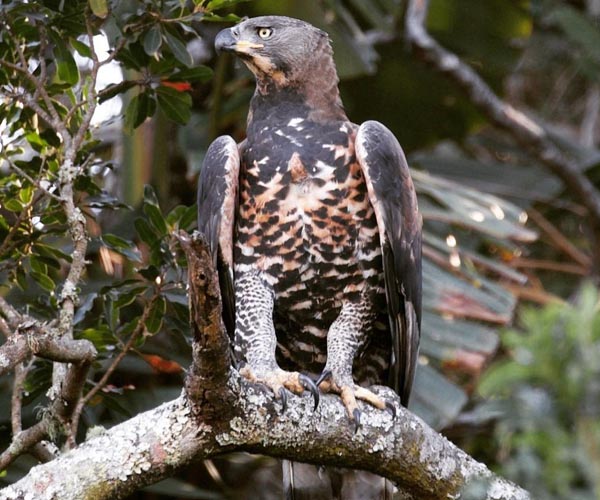
The crowned eagle possesses unusually large talons and strong hind legs and may kill by crushing the skull. They are strong enough to go after prey 4-6 times their own weight. Their talons are strong enough to break spines and crush skulls.
The Crowned Eagle, is the only known bird to be confirmed as having viewed humans as prey. In one case, a 7-year-old boy was ambushed by a crowned eagle, damaging the boy’s throat and chest. In another case, the skull of a human child was found in the nest of a crowned eagle pair.
6. Ostrich
Ostrich may look innocent and dumb if you look at some memes, but of all the living birds, the ostrich is among one of the most dangerous birds in the world. It is the largest flightless and one of the strongest birds, making it dangerous for humans.
The ostrich is the tallest and heaviest living bird. In one stride, an ostrich can cover up to 16 feet. A frightened ostrich can achieve a speed of 72.5 kilometers per hour.
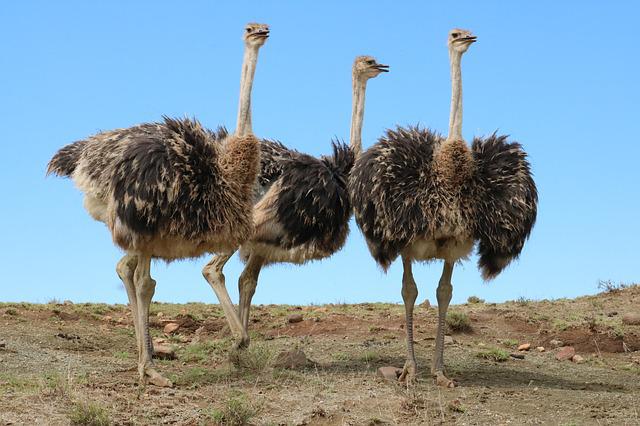
Typically, a male ostrich can weigh up to 145 kgs while the females usually weigh less. In terms of height, a male ostrich can grow from close to 7 feet up to 9 feet, and a female from 5.7 to 6.2 feet.
So imagine this large bird running towards you, it can definitely inflict some serious damage or even death. It is even said that an ostrich can even kill a lion with a single kick.
Ostrich can kill you in three ways: either ramming and jumping on you, kicking, and repeatedly pecking. They will ram the person with their breastplate. This ram attack will knock the person over, and then it jumps on top of them, 150 kgs on your chest!
Ostriches can kick with their powerful feet, armed with long claws, which are capable of disemboweling or killing a person with a single blow. They also effortlessly deliver quick, vicious pecks.
Although they don’t prey on humans, ostriches have been known to injure and kill when provoked. Ostriches live peacefully and do not attack humans unless they feel threatened or cornered. Nevertheless, when they attack humans, they go all out by protecting themselves, their young, eggs, and territories.
5. Bearded Vulture
The Bearded Vulture also known as Lammergeier means “lamb-vulture” in German. Due to its appearance and diet, the vulture had a nasty reputation for carrying away lambs, calves, and even children. Given what is known today about the bird, though, this claim is obviously not true. But its size and habits even scare people today.
The bearded vulture is the only animal that feeds almost exclusively on bone about 70-90% of its diet consists of bones. It is known as the “bone-eater”. They throw larger bones from a height onto rocky slopes in order to break them and immediately descend after them in a characteristic spiral.
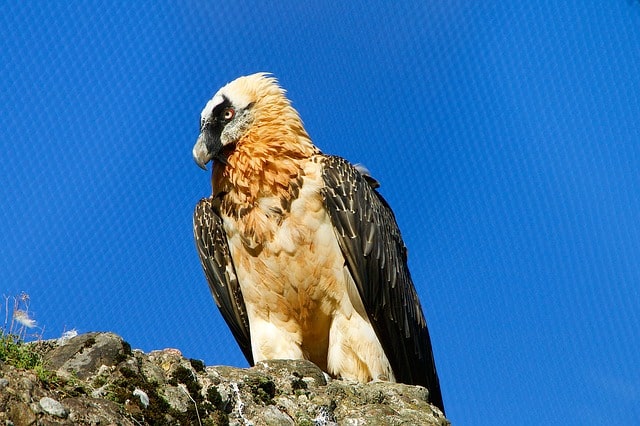
Bearded Vultures often reach lengths of more than 4 feet tall, with a wingspread of nearly 3 meters (10 feet). They can weigh between 4.5 – 7.2 kg. They inhabit mountainous regions from Central Asia and eastern Africa to Spain.
Despite the chilling role they play in stories and myths. They dine mostly on dead animals and have no incentive to attack humans.
Historically, the bearded vulture was considered a dangerous threat but they are dangerous only if they feel threatened.
4. Red-Tailed Hawk
Hawks are impressive predators. They have strong eyesight and sharp claws. Hawks are intimidating birds of prey that are dangerous to many small animals and other birds. The most dangerous bird in the world is the Red-tailed Hawk.
They are the most common hawk in North America. In 2006, a red-tailed hawk attacked 30 or more people on the Village Greens Golf Course in Woodridge, Illinois.
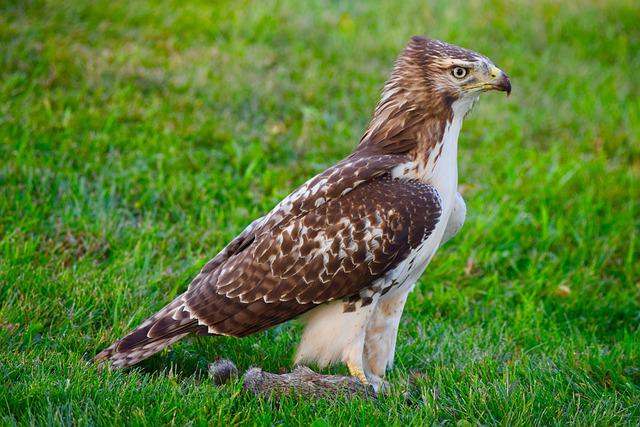
The Red-tailed Hawk has a wingspan of up to six feet. Their feet are equipped with sharp, curved talons for capturing prey, and their strong beaks are hooked for biting and tearing flesh. It preys on small animals and other birds by swooping down from above at speeds that can reach 110 miles per hour.
They ‘hover-hunt’ by flapping in place over potential prey, and by swooping down to grab prey with their sharp talons. This is what you call death from above for sure.
In most cases, a hawk will attack a human during nesting season. Therefore, if you keep away from its nest, you won’t face an attack from a hawk.
3. Harpy Eagle
The Harpy Eagle is one the largest and most powerful raptors and among the largest extant species of eagles in the world. Harpy eagles are basically in a three-way tie for the title of “world’s largest eagle” with the Steller’s sea eagle and the Philippine eagle. But surely Harpy is the strongest in the world.
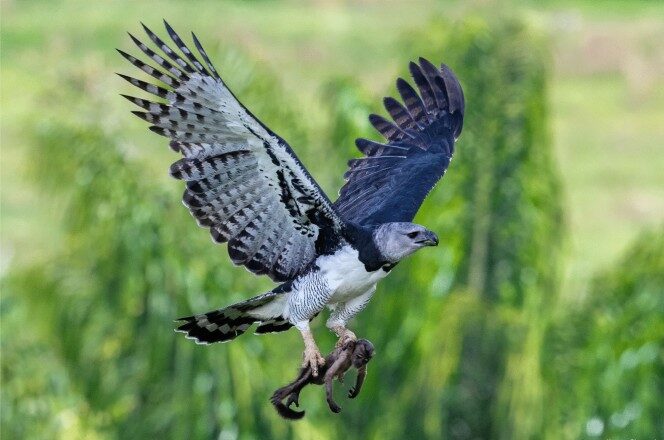
They are rarely seen in their natural habitat. They are found in Mexico, through Central America, and from South America to as far south as Argentina. Harpy eagles possess the largest talons of any living eagle, their legs can be as thick as a small child’s wrist, and their curved, back talons are larger than grizzly bear claws at 5 inches long.
Female harpy eagles typically weigh 6 to 10 kg, males are smaller than females and may range in weight from 4 to 6 kg. They have been recorded as lifting prey weighing up to their own body weight. This means they can definitely carry small pets and even babies.
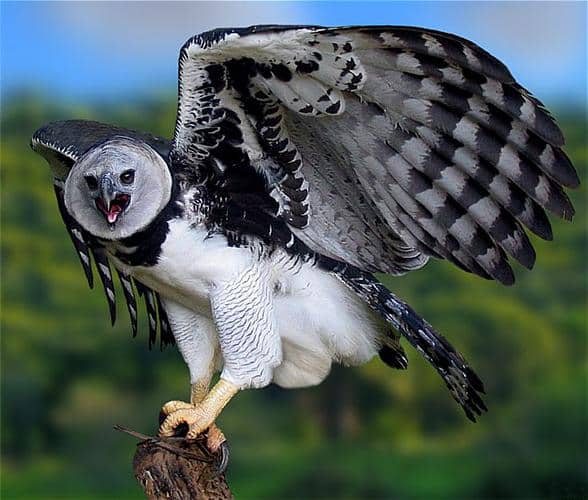
Harpy eagles may measure from 2 ft 10 inches to 3 ft 6 inches in total length with a wingspan of more than 7 ft. The deadly talons of a harpy eagle can exert over 50 kilograms of pressure,
They have a grip strength of approximately 530 psi crushing the bones of their prey and instantly killing their victim, more than enough to crush the human skull. A harpy also feeds on opossums, porcupines, young deer, snakes, iguanas, monkeys, and raccoons.
2. Cassowary
Next up on our list is the Cassowary – a large, flightless bird that is native to Australia and South East Asia. These birds are closely related to emus, but are much larger and resemble large, flightless ostriches. They are extremely territorial and will attack humans if they feel threatened. There have been many reported incidences of people being seriously injured or even killed by these birds.
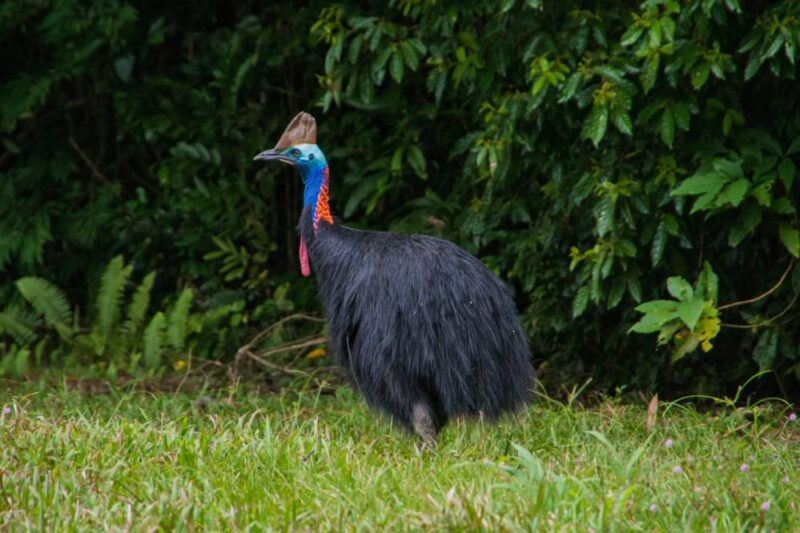
The Cassowary is said to be the most dangerous bird in the world. They can run extremely fast up to 50 kmph and jump several feet into the air when they feel threatened. They have very sharp claws on their toes and have been known to use them to disembowel their victims. The claw on the inner toe can reach lengths of 5 inches.
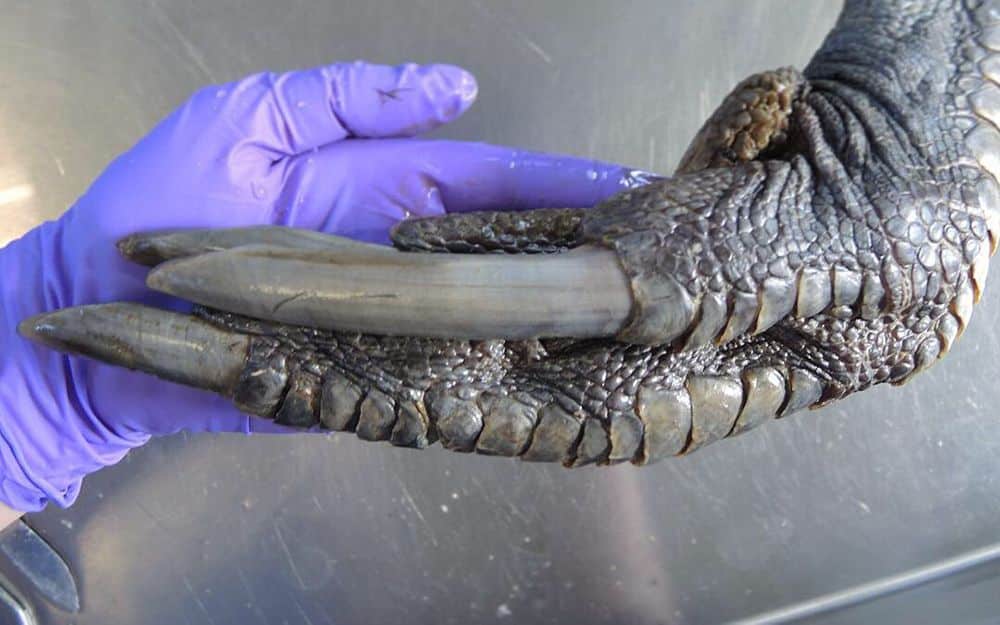
Young birds and chicks are more likely to attack humans, as they are protective of their territory. Although cassowaries are huge, they are surprisingly agile and can jump over a fence up to 2 meters tall. If a human comes across one of these birds, it is best just to leave it alone.
The cassowary is easily the most dangerous bird in the world and is often referred to as a “walking missile.” These birds can grow up to 7 feet tall and weigh over 75 kgs. They have razor-sharp claws that can slice through flesh, and they’re not afraid to use them – cassowaries have been known to attack and kill humans.
On 12 April 2019, a 75-year-old man was attacked by the Cassowary on his property in Florida, USA. His injuries were so severe that he later died in hospital.
1. Pitohui
Pitohui is a small bird found throughout the Pacific Islands. It is the only known bird that is poisonous, thanks to a diet that includes poisonous berries and beetles. The pitohui can deliver poison via its feathers, and the toxins on its feathers can cause a burning sensation if you touch them.
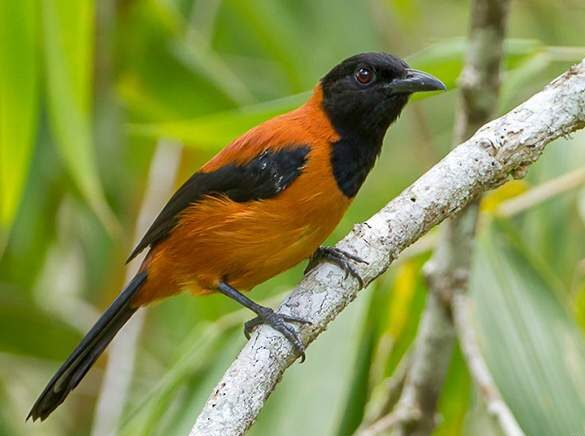
A single drop of its blood can kill a full-grown adult, That’s because of the toxin that their bodies produce – batrachotoxin. Among the different pitohui species, the most dangerous has bright red and black plumage.
They’re about 6 to 9 inches long. They have long, downward curving bills and bright yellow eyes. They’re social birds and often perch close together.
What are these birds doing with poison?
Scientists aren’t sure why this tiny bird has such potent toxins in its blood, but they have a few theories. One is that the toxins may be a way to protect it from enemies. Another theory is that they may serve as an antibiotic, helping the pitohui fight off diseases in its diet of toxic beetles.
Despite its toxicity, it is a favorite among bird-watching groups and is often referred to as the “poisonous pleasure”.

